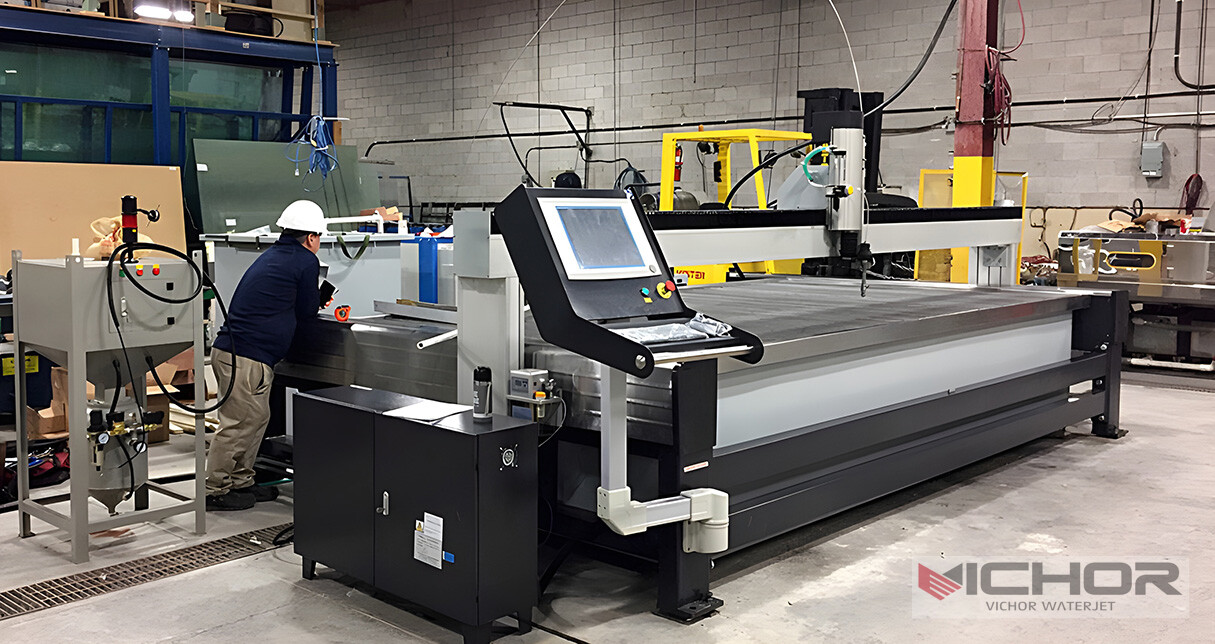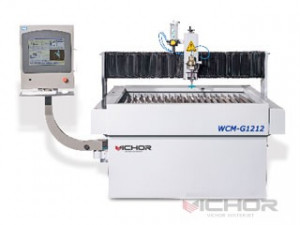
Your Content Goes Here
The world of precision cutting has witnessed a significant shift with the advent of table top waterjet systems. No longer confined to massive industrial floors, the power of abrasive waterjet technology is now accessible in a compact, benchtop format. These innovative machines pack the core capabilities of their larger counterparts into a significantly smaller footprint, opening doors for smaller workshops, research labs, educational institutions, specialized manufacturers, and even high-end prototyping studios. This guide delves deep into the world of table top waterjet systems, exploring their features, advantages, applications, and what makes them a transformative tool for modern fabrication.
What Exactly is a Table Top Waterjet? Core Technology Explained
At its heart, a table top waterjet utilizes the same fundamental principle as industrial-scale waterjets: harnessing the immense cutting power of a high-pressure stream of water, often mixed with abrasive garnet, to slice through materials. Here’s the breakdown:
Ultra-High Pressure Pump: The core component. It pressurizes ordinary water to extreme levels, typically between 30,000 PSI (2,068 bar) and 60,000 PSI (4,136 bar) or even higher for some models.
Intensifier Technology: Most table top waterjet pumps use intensifiers. A hydraulic pump drives a large piston, which in turn forces a smaller piston to move water. This amplifies the pressure dramatically within the smaller water cylinder.
Cutting Head: The pressurized water is forced through a tiny jewel orifice (usually diamond or sapphire), creating a supersonic stream. For cutting hard materials, abrasive garnet is introduced into this stream within a mixing tube, creating an erosive “sandblasting” effect at microscopic speeds.
Precision Motion System: A compact, highly accurate CNC (Computer Numerical Control) system moves the cutting head precisely over the workpiece mounted on the cutting table according to programmed paths (usually from CAD/CAM software).
Catch Tank: Located beneath the cutting grid, this tank holds the water and spent abrasive after cutting, allowing for filtration and recirculation or safe disposal.
The table top waterjet integrates all these elements into a single, relatively small unit designed to sit on a sturdy workbench or dedicated stand.
Key Features & Specifications of Modern Table Top Waterjets
While specific features vary by manufacturer and model, modern table top waterjet systems share several defining characteristics:
Compact Footprint: This is the defining feature. Units are typically designed to fit within spaces ranging from a few square feet up to the size of a large desk, making them ideal for constrained environments.
Lower Pressure Options (Often): While some high-end benchtop models reach 60k+ PSI, many operate effectively in the 30k-55k PSI range, sufficient for a wide array of materials while keeping costs and complexity lower.
Smaller Cutting Envelope: Compared to floor models, the X-Y cutting area is naturally smaller (e.g., 24″ x 24″, 36″ x 24″, 48″ x 24″ are common ranges). Z-axis travel (head height) is also more limited.
Integrated Design: Pump, control system, cutting head, and catch tank are often housed in a single cohesive unit or closely coupled modules, simplifying setup.
Simplified Controls: User interfaces are frequently designed for ease of use, often featuring touchscreens and intuitive software, sometimes even cloud-based operation.
Reduced Abrasive & Water Consumption: Due to the smaller scale, they inherently use less abrasive garnet and water per hour of operation compared to large industrial jets, reducing ongoing operational costs.
Lower Power Requirements: Generally operate on standard single-phase or common three-phase power (e.g., 208V, 240V), unlike large industrial jets needing heavy-duty three-phase power.
Quieter Operation (Relatively): While never silent, advanced pump designs and enclosures make modern table top waterjet systems significantly quieter than large industrial units.
Unlocking Versatility: Applications of Table Top Waterjet Systems
The table top waterjet shines due to its unique combination of capabilities in a small package:
Prototyping & R&D: Rapidly iterate complex parts from diverse materials without heat distortion or mechanical stress. Ideal for engineers and designers.
Small Batch Production: Perfect for low-volume manufacturing, custom orders, and job shops needing high precision without large capital investment in floor space.
Educational Institutions: Universities, colleges, and technical schools can bring advanced waterjet cutting technology into labs for hands-on learning without massive infrastructure.
Specialized Workshops: Jewelers, artists, model makers, and specialty fabricators (e.g., composites, electronics enclosures) benefit from the ability to cut intricate designs in delicate or tough materials.
Tool & Die: Cutting blanks, fixtures, jigs, and specialized tool components from metals and composites.
Electronics: Precision cutting of circuit board substrates (like FR4), insulators, and thin metal shielding.
Medical Device Manufacturing: Prototyping and small-scale production of components from biocompatible metals, plastics, and composites.
Aerospace & Defense (Small Components): Cutting intricate parts from titanium, aluminum, composites, and specialized alloys for prototypes or limited-run applications.
Signage & Decoration: Creating detailed letters, logos, and decorative elements from metals, stone, glass, acrylics, and wood laminates.
Gaskets & Seals: Producing custom gaskets from rubber, cork, felt, and composite materials without tooling costs.
Material Compatibility: What Can a Table Top Waterjet Cut?
This is where the table top waterjet truly excels. Its cold-cutting process handles an astonishingly wide range of materials with exceptional edge quality and no Heat-Affected Zone (HAZ):
Metals: Steel (mild, tool, stainless), aluminum, brass, copper, titanium, inconel, hastelloy (thicknesses vary by machine power, typically up to 1/2″ or more on softer metals).
Plastics & Composites: Acrylic (PMMA), polycarbonate, PVC, ABS, G10/FR4, carbon fiber, fiberglass, Kevlar, Delrin, UHMWPE. No melting or toxic fumes.
Stone & Tile: Granite, marble, slate, porcelain, ceramic tile (for intricate inlays, mosaics, small decorative pieces).
Glass: Soda-lime, tempered (with care), borosilicate (for artistic pieces, scientific components).
Foams & Rubbers: Polyurethane foam, EVA foam, neoprene, silicone, natural rubber.
Exotic Materials: Laminated materials, honeycomb structures, brittle materials that fracture with other methods.
Food (Pure Waterjet): Using only high-pressure water (no abrasive), some systems can cut cakes, frozen foods, and other products hygienically.
The versatility of a table top waterjet makes it a true “one machine for many materials” solution in compact settings.
Advantages Over Traditional Cutting Methods: Why Choose Benchtop Waterjet?
Investing in a table top waterjet offers compelling benefits compared to lasers, plasma, routers, saws, and EDM:
No Heat-Affected Zone (HAZ): The cold-cutting process preserves material properties, prevents hardening, warping, or micro-cracking in metals, and avoids melting/burning edges in plastics and composites. This is critical for structural integrity and precision.
Material Versatility: As detailed above, it cuts almost anything. Lasers struggle with reflective metals and many composites. Plasma damages thin materials and plastics. Routers can’t cut metals effectively. Saws lack precision for complex shapes.
Exceptional Precision & Edge Quality: Capable of holding tight tolerances (often +/- 0.005″ or better) and producing smooth, near-net-shape edges, frequently requiring minimal or no secondary finishing. Intricate details and sharp corners are achievable.
Minimal Kerf & Material Savings: The cutting stream is very narrow (kerf width), resulting in less material waste, especially valuable for expensive metals and composites. Nesting parts closely maximizes material yield.
Ease of Use & Quick Setup: Modern CNC controls and intuitive software make programming and operation accessible. No specialized tooling (dies, punches) is needed for different materials or shapes – just change the CAD file.
Reduced Environmental Impact (Compared to some): No toxic fumes (like laser cutting certain plastics), minimal hazardous waste (spent abrasive is inert). Water recycling systems further enhance sustainability.
Lower Barrier to Entry: Significantly lower cost, space requirement, and infrastructure needs than a full-scale industrial waterjet, bringing this technology within reach of smaller entities.
Choosing the Right Table Top Waterjet: Key Selection Criteria
Selecting the ideal table top waterjet requires careful consideration:
Primary Materials & Thickness: What will you cut most often? What are the maximum thicknesses? This dictates the required pump pressure (PSI/Bar).
Required Cutting Envelope (X, Y, Z): Measure the largest parts you need to produce. Allow space for clamping. Consider Z-height for thicker materials and potential taper compensation.
Precision & Tolerance Needs: What level of accuracy is critical? Research the machine’s repeatability and positioning accuracy specs.
Pump Technology & Reliability: Investigate the pump type (intensifier, direct drive), expected lifespan, maintenance requirements, and warranty. Look for proven durability.
Control System & Software: Is the CNC controller user-friendly? What CAM software is included? Is it compatible with your existing CAD workflow? Look for features like taper compensation.
Abrasive Delivery System: How is abrasive fed? Is it efficient and reliable? How easy is it to refill?
Catch Tank & Filtration: Size, ease of cleaning, and filtration efficiency for water recycling are crucial for maintenance and environmental compliance.
Footprint & Facility Requirements: Measure your available space precisely. Verify power requirements (Voltage, Phase, Amperage). Consider noise levels and potential need for additional ventilation/drainage.
Support & Service: Availability of technical support, training, spare parts, and local service technicians is vital for minimizing downtime.
Budget: Consider not just the initial purchase price but also operating costs (abrasive, water, electricity, maintenance, pump rebuilds).
The Future of Table Top Waterjet Technology
The table top waterjet market is dynamic, with ongoing innovations:
Higher Pressures in Compact Forms: Expect continued development pushing PSI limits in benchtop pumps for faster cutting speeds and thicker material capacity.
Enhanced Intelligence & Automation: Integration of AI for predictive maintenance, automated parameter optimization for different materials, and improved motion control for even higher precision and surface finish.
Smarter Software: More intuitive, cloud-connected CAM software with features like automated nesting, real-time monitoring, and remote job management.
Improved Abrasive Efficiency: Developments in abrasive mixing and delivery systems to further reduce garnet consumption.
Advanced Filtration & Recycling: More efficient and compact closed-loop water recycling systems, minimizing water waste and disposal needs.
Hybrid Additive/Subtractive Systems: Integration of table top waterjet heads with 3D printing platforms for combined manufacturing processes.
The table top waterjet is more than just a scaled-down industrial tool; it represents a democratization of high-precision, cold-cutting technology. By offering unparalleled material versatility, exceptional accuracy, and the absence of heat distortion in a compact and relatively affordable package, it empowers a vast new range of users. From inventors and artists to specialized manufacturers and educators, the table top waterjet is transforming how complex parts are prototyped and produced on a smaller scale. As technology continues to evolve, making these systems even more capable, efficient, and user-friendly, the impact of the table top waterjet on innovation and small-scale manufacturing is set to grow exponentially, solidifying its place as an indispensable tool in the modern maker’s arsenal.
continue reading
Related Posts
- 1371 words6.9 min read
- 1449 words7.3 min read




